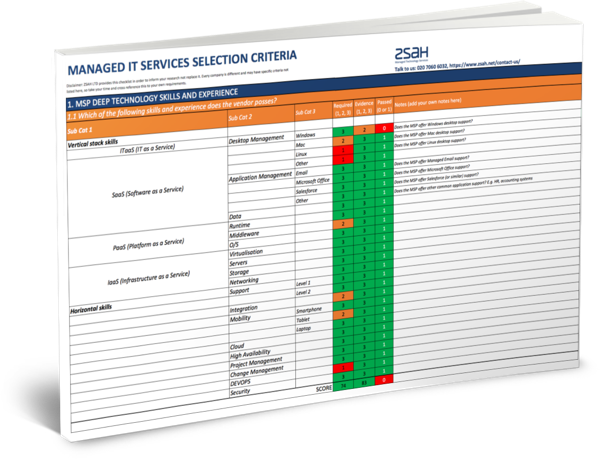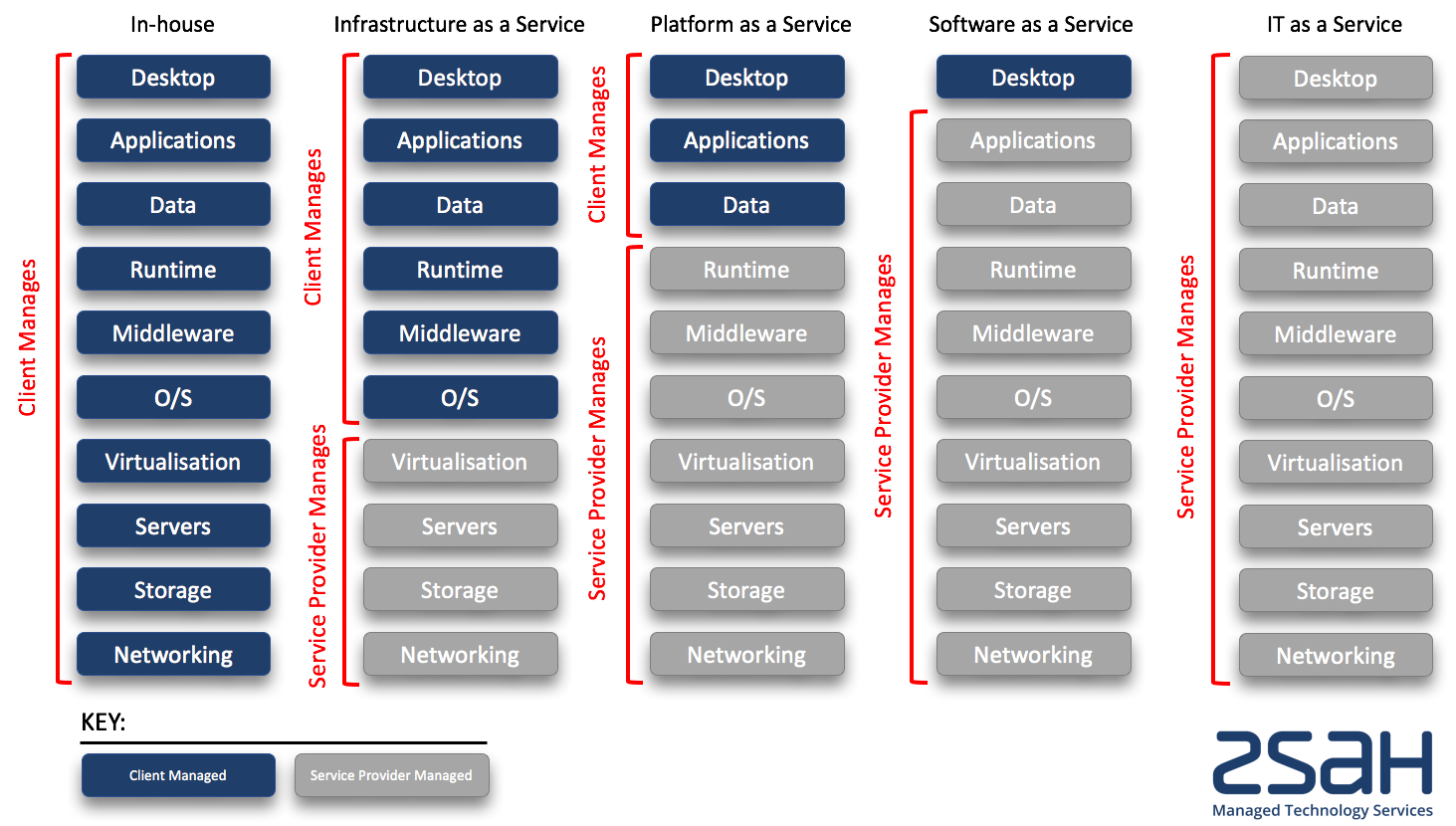Managed IT Services – The Ultimate SME Guide to Selecting a Provider

MANAGED IT SERVICES - INTRODUCTION
In this post, we are going to cover the "Where?", "Why?", "What?" and "How?" of selecting a managed IT services provider (MSP) to handle the IT services your organisation might require.
Over the past 15 years, we’ve responded to enough managed IT service provider RFP’s to know what the good questions are to ask and what the not so good ones are.
And, as we at zsah are an MSP (take a look here, here and here for more info) we promise we'll give you the inside track from the services provider perspective and won't pull any punches.
But, let’s start by saying that deciding on a managed IT services provider for your organisation is hard. If you've got to the stage of reading this blog post, you will already know that.
So we’ve taken the time to pull all this hard-fought knowledge together into one post as the Ultimate Guide to Selecting a Managed IT Service Provider just for you.
"Cloud has gone from becoming mainstream, to dominating IT segments, to being the new normal."
- John Dinsdale, Synergy Chief Analyst
What Will I Learn By Reading This?
Four things:
GET THE CHECKLIST!
Want a printable copy of the checklist in an Excel spreadsheet format to help you select your Managed IT Services partner?

BY ENTERING YOUR EMAIL YOU AGREE TO RECEIVING OCCASIONAL EMAILS FROM US ON OUR PRODUCTS AND SERVICES. WE WILL NEVER SHARE YOUR EMAIL ADDRESS. UNSUBSCRIBE ANY TIME. PRIVACY POLICY.
1. WHERE DO MSPs FIT INTO TODAYS HYBRID IT ENVIRONMENT?
Let's start by discussing where managed service providers fit into the hybrid IT environment of today.
As Kevin L. Jackson (@Kevin_Jackson, Cloud Musings blog) renowned expert on cloud computing, cybersecurity, cognitive computing and big data analytics explains, most enterprises will probably be operating in a hybrid IT environment already, consisting of three components:
- A Traditional Data Centre: In this model, the enterprise pays for ownership of all the hardware and software. They also pay the salaries and benefits for the required operations staff. The enterprise has complete and total control of IT governance.
- Managed Service Provider: In this model, the enterprise pays a third party to provide IT hardware, software and professional services. The enterprise retains IT governance control through the negotiation and enforcement of a binding contract (Service Level Agreement) with the managed service provider (MSP). The enterprise also pays all the costs incurred by the MSP plus a negotiated profit. This option is cheaper than the traditional data centre if the MSP is more efficient than the contracting enterprise in the delivery of the contracted services.
- Cloud Service Provider: In the cloud computing option, the cloud service provider (CSP) pays for ownership of all hardware and software. The CSP also funds the salaries and benefits for the required operations staff. In this model, the CSP has complete and total control of IT governance.
Kevin goes on to state that Managed Service Provision is just an option that can and frequently does complement the other two models.
For instance, it's likely that larger organisations might still run certain app's or services in-house in a traditional data centre; use a managed service provider for a commodity service like email; and, use a cloud supplier for DevOps functions.
2. WHY OUTSOURCE YOUR IT SERVICES ... AT ALL?
There are many reasons why an organisation may decide to outsource their IT services. And, it's not just for financial reasons (although they are likely going to be the primary motivator for your C-suite exec's).
Below is a list of common reasons we typically come across. If you are starting out building a case for a managed IT services provider, these may help you decide what the main motivators are:
1. To focus on your core competencies

This is one of the main reasons organisations outsource their IT services and as a result, needs little explaining, but let’s just do a quick recap:
Maybe you’re a law firm?
Or a healthcare company?
A call centre?
Or a public sector organisation?
Whatever line of business you’re in, you have to ask yourself this simple question,
“Is managing our IT services really something we are qualified to or want to do?”
And perhaps more importantly,
“Do we have the skills to keep up with the advances in technology if we keep it all in-house?”
You don’t make the computers on your desktop, so why should you maintain them? Or the networks, servers and a host of other technology modern businesses use for that matter.
There’s really only downside for most modern organisations.
2. Cost reduction

Salaries of your IT support staff are just the beginning.
When you take into account the fully loaded costs of a full-time employee (FTE), the real cost can be double or sometimes even more of the salary costs (UK readers can get ballpark figure costs of their employees here, have a look at this).
A managed IT service provider can help you reduce cost by centralising and sharing these overheads across multiple customers.
3. Capital Expense

What enterprise isn’t challenged with constrained capital expenses?
Ok, so there is Apple™.
But for just about everyone else, making those capital investment choices are difficult and much more inclined to be made if it’s for a genuine revenue generating initiative, rather than an operating expense.
Managed IT services can be priced and paid for as an operating expense where there is usually greater flexibility to make decisions.
And we all know the saying about having a happy CFO right?
A happy CFO is the way to go!
4. Increased Efficiency

A managed services provider can implement industry standards, best practices, automation and better IT controls across hybrid environments and help you plan, procure and govern multiple technology stack models and suppliers.
How are you going to do all of that alone?
You may have the best business in the world, but if your technology infrastructure is prone to outages, or worse, vulnerable to hackers, you are going to have a tough time convincing your prospects you are a safe pair of hands to do business with.
5. Access to skills

Having access to a greater pool of IT talent can mitigate single (human) point of failure scenarios and offer greater skill diversity to your organisation.
Furthermore, you have to ask yourself, where are tech people going to be happier?
In your law firm, where everyone talks about law all day, or in a tech company, where everyone talks about and shares the latest memes on the "IT Crowd”?
That’s right, there’s really no comparison.
6. Contractually enforced service level agreements that are metric driven

When your service levels are actually backed by contractual SLAs rather than favours owed to the "in-house IT guy”, you tend to get better service.
Service providers have an incentive to make everything as cost-effective and slick as possible using the latest time-saving tools, processes and governance.
And that’s not all.
The types of complex issues an internal IT support person sees once a year, a managed services engineer probably see’s once a week, meaning they know how to resolve them, or better still, be proactive and anticipate them so as to avoid them in the first place.
7. Improved security, business resilience and compliance

Security has shot to the top of many CTO’s and CEO’s agendas in recent years. And quite rightly so.
The financial integrity, not to mention reputation of your organisation is at stake if you do not take adequate precautions to lock down your technology.
And, as the Sage of Omaha, Warren Buffet, himself once said,
“It takes 20 years to build a reputation and five minutes to ruin it. If you think about that, you'll do things differently"
Escalating cyber threats, regulation like GDPR and a hybrid technology landscape can make it difficult for an in-house IT to keep up with the demands of a rapidly changing technology landscape.
From basic patch management to vulnerability scanning, DR and data backup, there’s a whole host of skills and best practice that an IT department must have.
An IT services provider can bring industry best practice, procedures and infrastructure to your organisation and make sure they all work to provide a more holistic approach to IT risk management.
8. Access to technology innovation

Managed IT providers tend to attract people with a deep interest in technology, who are then invested in through onboarding and training programs to build and advance their skill set further.
This makes sense when a single provider can be managing the IT systems of multiple companies.
But when it’s just one organisation, unless you’re huge, the investment numbers to keep your IT staff skilled in relevant technology and processes can be difficult to justify, even prohibitive for smaller companies.
There’s a strong correlation between having staff with better skills leading to greater innovation and your organisation can leverage the benefits that a managed service provider offers to enhance your own products and services.
9. Flexibly and scalably adapt to changing business conditions

One thing is for certain in the technology world, things don’t stand still.
Companies these days need speed to market and rapid access to compute power without all the overheads of physically shipping servers into datacentres and the associated capital expenditure.
Having an IT organisation that aligns with the needs of the business, rather than the limitations of its own services, means being able to adapt, react and act on new opportunities as they arise and mitigate against regulatory and cyber threats.
10. Ability to impose the organisation's IT governance requirements

As Kevin L. Jackson (@Kevin_Jackson, Cloud Musings blog) points out, a managed service provider model allows the retention of IT governance control through the negotiation and enforcement of a binding contract or SLA (Service Level Agreement).
So, if you are more concerned with the "what" rather than the "how" a service is implemented, there is still plenty of scope for maintaining control.
3. WHAT CAN YOU OUTSOURCE?
These days, it's probably easier to list what services you can't outsource, although that will likely be a very short list!
So we are going to take the approach of looking at 3 common IT outsourcing arrangements compared to the traditional in-house option, to help you decide where on the spectrum you want your organisation to lie.
The Big-aaS List
As with all areas of technology, managed IT services have their own terminology, and it pays to know the key terms before diving in.
There are many types of managed IT services available today, most tending to end with "as a Service" ("aaS"), as in "Infrastructure as a Service" ("Iaas" for short).
We've listed some of the more common outsource service examples below, but it seems like every day there is a new aaS offering: from Desktop as a Service, Security as a Service, to Database as a Service (we've even seen Country as a Service).
On-premises or In-house
This is the traditional, some might say 'old-fashioned', approach where you have internal staff and your own premises (or rent space in a data centre) to host and manage the companies IT infrastructure.
From email and web servers to desktop computers and HR applications, it can still all be done by you, if you so desire!
However, as Kevin L. Jackson states, most companies these days operate in a hybrid IT environment where they might pick and choose what they outsource and the degree to which they outsource it.
Infrastructure as a Service (IaaS)
IaaS is at the lower end of the managed services spectrum and gives users automated and scalable environments with pre-configured physical and virtualised hardware. Amazon Web Services (AWS) Elastic Compute Cloud (EC2) is a well-known example of this.
It's generally up to the client to maintain the operating system, databases, security and applications, but they are provided with the storage, networking, servers or virtualisation containers.
Platform as a Service (PaaS)
PaaS solutions appeal to developers who want to spend more time developing instead of dealing with infrastructure related tasks like managing security or operating system updates.
Heroku, Microsoft Azure and Google Cloud Platform App Engine are well-known PaaS Solution examples and provide frameworks for quickly developing and deploying applications by automating infrastructure management.
Software as a Service (SaaS)
SaaS solutions are what most non-tech organisations require. SaaS is where a provider hosts the application and makes it available to the client through the Internet, usually via a browser.
Examples are Gmail, Salesforce or Office 365 which offers online versions of popular programs, including Word, Excel, Powerpoint and Outlook.
SaaS customers enjoy the benefit of the service without having to worry about any of the development, maintenance, support, updates, backups or disaster recovery, but are reliant on the service provider to perform, as well as their ability to conform to new regulatory policies like the European Unions GDPR.
IT as a Service (ITaaS)
A fully managed IT service or IT as a Service is the ultimate outsourcing arrangement, whereby the client hands over management of their entire IT infrastructure to one or more managed service providers.
The service providers look after everything from your desktop and mobile connectivity to networking and servers, even provide you with development resource if you need it.
Great if you're a law or accounting firm and don't need the distractions of managing complex IT environments and applications.
GET THE CHECKLIST!
Want a printable copy of the checklist in an Excel spreadsheet format to help you select your Managed IT Services partner?

BY ENTERING YOUR EMAIL YOU AGREE TO RECEIVING OCCASIONAL EMAILS FROM US ON OUR PRODUCTS AND SERVICES. WE WILL NEVER SHARE YOUR EMAIL ADDRESS. UNSUBSCRIBE ANY TIME. PRIVACY POLICY.
4. TOP 10 CRITERIA FOR SELECTING A MANAGED IT SERVICES PROVIDER THAT FITS YOUR REQUIREMENTS

In the last few sections, we covered the main reasons why organisations transition to a managed IT services provider and what they can transfer.
In this section, we're going to look at the key criteria you can use to evaluate and select a managed IT services provider (MSP) in order to determine a good fit for your organisation through the use of a simple checklist.
As Ian Moyse (@imoyse, Cloud Matters blog) points out, it's important to not only have the list of criteria but to also weight each criterion as to the importance each carries.
As it goes without saying that some organisations might find certain criteria super important whereas others will not so bear that in mind when doing your service provider research.
Disclaimer: We provide this checklist in order to inform your research not replace it. Every company is different and may have specific criteria not listed here, so take your time and cross reference this to your own requirements.
1. Deep technology skills and experience
1.1 Technology Services Maintenance and Management
Desktop Management
Application Management
Data
Runtime / Production Management
Middleware Management
O/S Management
Virtualisation
Server Management
Storage Management
Network Management
1.2 Horizontal Technology Services
Support
Integration
Mobility
Cloud Management
High Availability (HA)
Project Management
Change Management
DevOps
Security
1.3 Scalability and Availability of Key Staff
List of key staff, skillset and experience
2. Proactive, technology based incident management approach
Proactive preventative approach
Evidence of beyond monitoring and device management
Use of analytics to drive incident prevention
Evidence of Root Cause Analysis process
Incident management tracking and escalation paths
Regular (monthly) service review meetings
Quarterly strategy meetings to discuss performance, industry trends, and business planning
3. Alignment with industry best practices and ITIL standards
ISO/IEC 27001
ISO/IEC 27018
ISO/IEC 27017
SSAE16 & ISAE3402
CLOUD SECURITY ALLIANCE STAR (Security, Trust and Assurance Registry)
ITIL IT Service Management adherence
Transitioning process to assist in-house to service provider
Clear methods for communicating best practices
Induction process for new staff onboarding
4. Consistent processes, knowledge management and consolidated service visibility
Scripted processes for a repeatable methodology
Access to historical problem and resolution
Web based dashboard for real-time service visibility
Online tools for managing services
Flexible reporting
Systems for knowledge sharing
e.g. help desk or knowledge management software
Processes and organisation for knowledge sharing
5. Support for multivendor, hybrid environments and strong relationships
Ability to manage hardware, software and network products
Experience of managing private, hybrid and multivendor public clouds
Relationships and partnerships with leading vendors
Vendor neutral ‘broker’ approach to help you plan, buy, manage and operate
6. Consistent service delivery, with options for local / onsite resources
Onsite local branch or subsidiary support
Multi-location team organisation capability
7. Performance-based SLAs, crisis response times, project management
Contractual commitment to service levels
Financial penalties or consequences for non-performance
List of service open times, e.g. for helpdesk 24x365
Evidence of project management qualifications like Prince-II
8. Broad portfolio of managed IT services aligned to your business model
8.1 Able to flexibly add additional managed services to reduce services fragmentation
IaaS, PaaS and SaaS
Managed security
Resilience & DR
Mobility management, e.g. smart phones, laptops, etc.
Managed Hosting
Managed Cloud
8.2 Retention and reuse of existing IT kit
Retention and reuse of existing IT kit
8.3 Flexible financial models like pay-per-use
Flexible financial models like pay-per-use
9. Technology foresight and a path to innovation
MSP able to contribute to innovation
Brings proprietary insights in technology or process
Can leverage their network to help develop new business models and opportunities
10. Financial stability and reputation, company ratings, staff ratings
How long has the prospective partner been in business
Research annual reports and financial statements
Ask for customer references
Check public ratings including Google, Glassdoor, etc. for customer and staff feedback
SUMMARY
Selecting a managed IT services partner can be a daunting task, but for most organisations, the sooner you make the change, the quicker you will be able to focus on your core business and reap the benefits of new levels of service for those non-core activities.
Whoever you choose as your service provider, it's important to ensure that they are aligned both with your technical as well as your business needs and be flexible in their service provision in an increasingly hybrid IT environment.
Now it's over to you.
Have you enjoyed or found this post useful?
Do you have a story about how you outsourced your IT?
What happened?
Why not leave a comment below and let us know.
Note to readers: We'd like to thank cloud experts and all-round good guys, Kevin L. Jackson (@Kevin_Jackson, Cloud Musings blog) and Ian Moyse (@imoyse, Cloud Matters blog) for their invaluable input into this post.
GET THE CHECKLIST!
Want a printable copy of the checklist in an Excel spreadsheet format to help you select your Managed IT Services partner?

BY ENTERING YOUR EMAIL YOU AGREE TO RECEIVING OCCASIONAL EMAILS FROM US ON OUR PRODUCTS AND SERVICES. WE WILL NEVER SHARE YOUR EMAIL ADDRESS. UNSUBSCRIBE ANY TIME. PRIVACY POLICY.



Keep up the great work guyz.
Many thanks Vernon!
Make a more new posts please 🙂
___
Sanny
This is my first time i visit here. I found so many entertaining stuff in your blog, especially its discussion. From the tons of comments on your articles, I guess I am not the only one having all the enjoyment here! Keep up the good work.
Hosted PBX Dallas
Nice posts! 🙂
___
Sanny
Excellent post. I want to thank you for this informative read, I really appreciate sharing this great post. Keep up your work.
Voip companies
Appreciate the feedback!
I am glad to find it. There are so many developers working on this part but this is one of the best innovative post ever. Thanks for such post.
Well-written article, thanks for sharing this up here. It’s nice to see the long list of comments here. I’m quite amazed with the response this blog has garnered. Kudos!! Absolutely agree that the sooner a company decides to switch an MSP, the sooner they’ll reap the results for their business.
Thank you Braden! Glad our article helps.